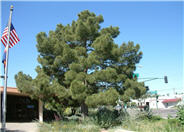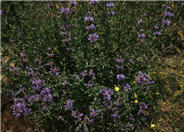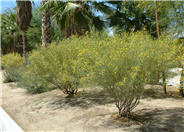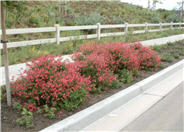
Common name:Allepo Pine
Botanical name:Pinus halepensis
The Pinus halepensis exhibits moderate growth to 30' or more, with an open, irregular crown. Mature trees have horizontal spreading branches, 20' wide and more. The needles light green in color, with a length of 2.5"- 4". Flowers are insignificant. Cones appear on the tree after a few years, rounded and oval shaped, about 3" long. Allepo Pine prefers full sun and low watering, although it will drop its needles if water stressed.

Common name:Aromas Sage
Botanical name:Salvia 'Aromas'
The Aromas Sage is a selection that stays more compact than the Cleveland Sage and grows to about 3'-5' high and wide. It has distinctively fragrant, gray green foliage and whorls of violet blue flowers in spring and summer. It can withstand strong winds and is deer resistant. It prefers full sun and well draining soil.

Common name:Feathery Cassia or Senna
Botanical name:Senna artemisiodes
This evergreen shrub grows to 4'-6' tall and wide. It has leaves that are narrowly pinnate, forming feathery sprays of silvery foliage. Its showy yellow flowers appear at branch tips from late winter through early summer. A very tough plant, this variety will survive under desert conditions or near the coast. It will even tolerate clay soils if kept dry during the summer. The plant is damaged below 20 degrees F.

Common name:Red Star Autumn Sage
Botanical name:Salvia greggii 'Red Star'
This shrub will grow 1'-4' tall and 1'-4' wide. It has glossy green leaves with red flowers that bloom from fall to spring.
| Designer: Anon | Hillside Grandeur |
Photographer: GardenSoft |
Soils and Compost:
Practice grass-cycling by leaving short grass clippings on lawns after mowing, so that nutrients and organic matter are returned to the soil.
Water Saving Tip:
Apply a layer of mulch around plants to reduce moisture loss.
Choose organic mulches, such as shredded bark, compost or aged sawdust.
Integrated Pest Management:
Attract, or buy beneficial insects such as ladybugs and lacewings to control pest outbreaks in your garden.

